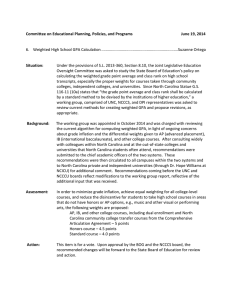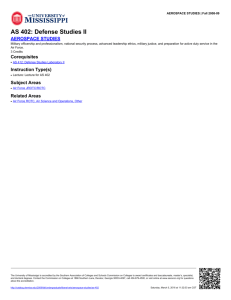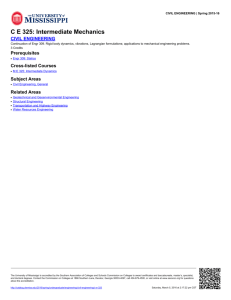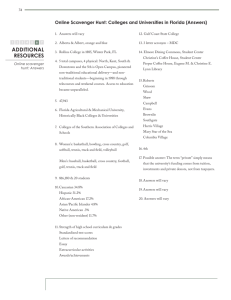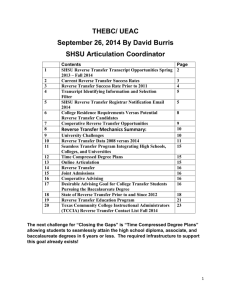What is Reverse Transfer? - Oklahoma State Regents for Higher
advertisement
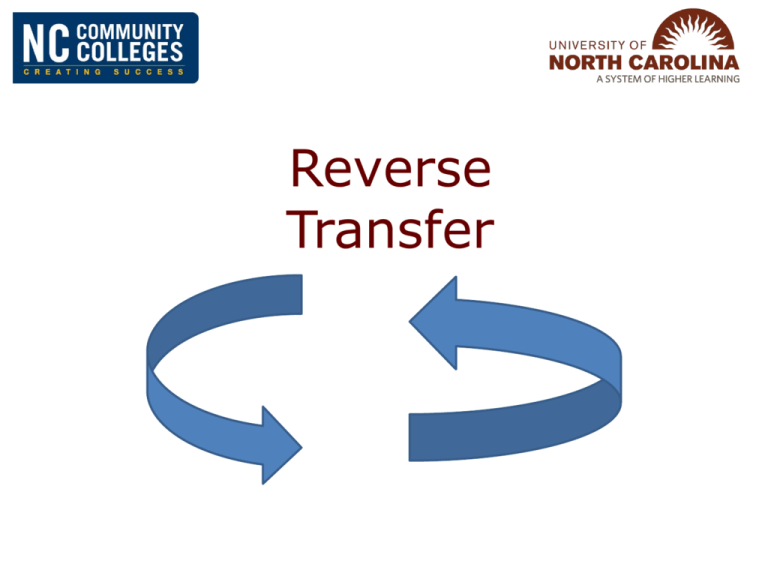
Reverse Transfer What is Reverse Transfer? The awarding of an associate degree to students who have previously attended a community college & fulfilled the associate degree requirements while working towards a bachelors degree Why is it Important? “Experts from the Center on Education and the Workforce at Georgetown University say that, by 2018, 308,000 of the expected 541,000 job vacancies in Oklahoma will require postsecondary credentials. Indeed, 57 % will require postsecondary education by 2018.” Lumina’s A Stronger Nation through education 2013 report Why is it Important? Lumina Foundation, 2015 report: “A Stronger Nation through higher education Why is it Important? Nationally only 56% of early transfers complete their bachelors “Making the decision to transfer prior to finishing an AA or AS is difficult and often involves monetary constraints and/or required course access. Adult transfer students especially can get mired in the often disjointed and protracted journey toward the culmination of their efforts. I foresee this opportunity to receive acknowledgement of the earned AA or AS degree as a way to help bolster the transfer student’s psychological resolve to complete the four year degree. (UNC-Charlotte Female participant) Why is it Important? El Paso, Texas “Looking at student outcomes once students earned their associate’s degree, a substantial portion of the sample completed their bachelor’s degree as of Spring 2014 (n=1,740; 84%).” Reverse Transfer and Degree Awarding Agreements to Help Transfers earn their Associates at a Four Year School, R. Boren, D. Ekal, A. Vasquez, C. Westman, D. Hendry. Why is it Important? “Very few (less than one percent) are still persisting toward their four year degree, and only 16 percent (283) students left without completing their degree at UTEP.” Reverse Transfer and Degree Awarding Agreements to Help Transfers earn their Associates at a Four Year School, R. Boren, D. Ekal, A. Vasquez, C. Westman, D. Hendry. “I'm finding that the prospect of having my official associate's degree is helping me to push me over the "2 year-hump" to my bachelor's program.” Email UNC-Charlotte Female Most important the student gets a credential they have earned. Advantages to students: • Possible career advancement • Better jobs and increased income while in college • Individuals with associate degrees have lower unemployment rate than those with only a high school diploma or some college • Possibly meet general education requirements at 4-year institution Advantages to Institutions • Re-examine reasons students are not graduating with the associate degree Could indicate: A need for review of articulation agreements A need for new technology A review of a particular course A review for graduation processes • Graduates for community colleges • Some research indicates it is an incentive for students to complete the bachelors 16 CWID States 495 CWID institutions 2940 degrees by 2014 7367 degrees by 2015 12 States – legislation 12 non-CWID States exploring or planning 9 non-CWID States piloting or implementing • • • • National Student Clearing House Began implementation in July 2015 www.reversetranfer.org Phase 1: – Facilitates the submission of files from the Host Institution, notification of Degree Granting Institution(s) and downloading of files by DGI(s) As of 7-20-2015 NC has over 1,000 credentials Number of Reverse Transfer Credentials in Twelve Initial CWID States by June 2015 0 Arkansas Colorado Florida Hawaii Maryland Michigan Minnesota Missouri New York North Carolina Ohio Oregon 400 800 1200 1600 249 68 275 1458 820 979 1362 189 0 665 1002 300 No Evidence Reverse Transfer Associate’s Degree Reduces Student Retention 100% Retained in Spring 2014 96% 95% 93% 91% 90% 90% 91% 85% 80% Received RT RT Eligible, no Earned AA or Ineligible for degree in Fall RT degree in higher before RT 2013 Fall 2013 fall 2013 Average Retention Rate Fall 2014 to Spring 2015 retention rates of University of Hawaii transfer student cohort; Retention rates include students who earned bachelor’s degrees Oklahoma’s Transfer • 2013-14 • Public 27686 • 35%=9690 • Private 2979 • 35%=1042 NC’s Higher Education Structure State Board of Community Colleges Board of Governors North Carolina Community College System (NCCCS) University of North Carolina System (UNC) 58 community colleges 16 public universities and 1 high school 36 Private Colleges and Universities What are the key concepts that need to be considered? FERPA What consent options do you consider? • Add questions to admissions application – Pros: Reaches a wide audience, raises awareness about the program before enrollment – Cons: Difficult to target, does not reach already enrolled students • Send link to web form – Pros: Easy to set up, easy to target population – Cons: Does not force response FERPA What problems do we want our technology to solve? Opt-in/Opt-out • Obtain consent • Only ask eligible population – Avoid unnecessary questions/ confusion from students – Save staff time • All of eligible population • Mandatory response • How will you get students to opt-in? –Is there a common technology application that can be leveraged (eg. single sign-on or ERP system) so that each institution does not have to have their own process and code? –Would you standardize processes and/ or wording across institutions or have each create their own? 8000 Number of Students 7000 6000 4762 +505 5000 4000 3648 +1114 2487 66% +1161 3000 2000 5267 31% 1000 0 1st Contact 2nd Contact 3rd Contact 4th Contact North Carolina (n=~8,000) North Carolina’s Experiment Messaging Methods Consent Initial Results from Survey • Yes - 50% • No - 41% • Deferred - 9% Of those that said no: 14% - “I do not understand the RT program and its benefits” 8% - “I do not feel comfortable sending my course information” 42% - “I would prefer to wait and get my bachelor’s degree than get my associate’s degree now” 19% - “I do not think I qualify” 17% - “Other” Residency/Accreditation Admissions Financial Aid/Scholarships Graduation Performance Funding Who gets the student to review? Benefits of an A.S or A.A or ? Articulation Agreements What courses/grades are acceptable? Upper Division Courses Equivalencies MOU’s Transcripts Degree Audit Culture What technologies need to be considered? • What criteria will you use to match students from the 4-year colleges/ universities to the community colleges and then back from the community colleges to the 4-year colleges/ universities? – If you use SSNs, do you have these for every student? – Do you have a statewide unique ID? – What would you do with multiple matches? What problems do we want our technology to solve? • Limit burden on universities – Creation of transcripts • Automated, sustainable process – Short-term project funding • Limit burden on community colleges – Articulating of credit – Larger quantity of transcripts to process How do policy decisions affect IT? • Can we program just for this population if needed? • How is it stored in the system that the student is participating? • How is it currently used by others? • If we change this how does it affect others use of it? • Or could we add a value/attribute instead of changing or adding new fields? • Do we know what table this could/would be located in? What did North Carolina do? What is the Student Data Mart (SDM)? • All 16 UNC universities • Implementation began in 2013 • From flat file system to using web services to pull data straight from institution ERP (Banner and PeopleSoft) • Data about students, courses, programs, faculty, financial aid, facilities, degrees awarded • Information used for federal (IPEDS) and state reporting, to address legislative and other information requests, research, data-driven business process improvements, and Reverse Transfer transcripts • Started with campuses in Reverse Transfer grant How do you decide what population to send to the community colleges? • Files from NCCCS (2001 forward): – More than 16 credit hours at a single community college • Student Data Mart – Opt-in= Y – Between 50 and 90 cumulative credit hours – If the student has over 90 credit hours but has never been sent – More than 16 (SACs accreditation 25%) credit hours at a single community college (if not identified from CC files) • Community colleges will likely see an increase in transcripts to process. How can this burden be lessened (eg. common transcript formats, course crosswalks, automation of degree processing)? • What processes can be centralized and what will have to be done by each institution? Crosswalk • NCCCS has common course library and UNC does not • Crosswalk UNC courses to community college courses • Started by pulling and summarizing equivalencies from CCs • CCs met and agreed on “suggested” equivalencies Degree Audit/Program Evaluations • Colleges were able to run batch degree audit evaluations for all students included in download • Degree audit results were queried to determine what requirements each student was missing in a report • Manual comparison of Reverse Transfer Report and Missing Credits Report Missing Credits Report How are we scaling up to a state-wide program? Round 1 Round 2 Round 3 Round 4 Transcript Term Community Colleges (out of 58) UNC Institutions (out of 16) Spring 2014 15 Fall 2014 Fall 2015 34 Spring 2015 58 8 8 11 16 58 Scale-Up • Video Taped Training • Training Manual • Training Sessions • Webinars Lessons Learned • Involve a wide range if individuals for feedback from the beginning (UNC and CC registrars, transfer office staff, IT, advising staff and any others affected) • Focus on increased automation/ sustainability from the beginning or you will regret it • Take the time to do it right: get lots of opinions, Test! Test! Test!, pilot Lessons Learned • • • • • • • Full-time Director to coordinate Policy consistency Individual campus visits and training Communication is key Point Person for Student Questions Math Curriculum Alignment Resources • http://occrl.illinois.edu/projects/cwid/ • www.northcarolina.edu/reversetransfer • http://degreewithinreach.org/ Michelle Blackwell emblackwell @northcarolina.edu
